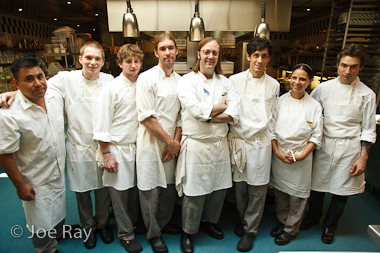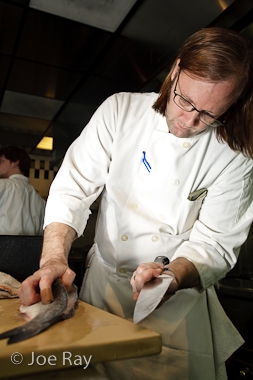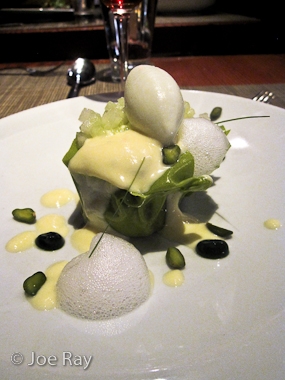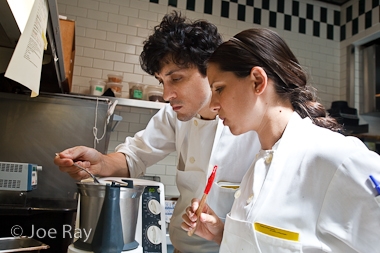Daniel Boulud & Wylie Dufresne - The Centurion Menu
Winter 2009 - Centurion Magazine




Walk down the street in New York City and on any given corner, you can get a noseful of a host of different cuisines. No matter what the budget, it is foodie heaven.
This diversity is no different at the top end, where chefs Daniel Boulud and Wylie Dufresne are like negative images of one another: Boulud’s restaurant Daniel is held up as the paragon of fine dining in New York and was recently awarded a third Michelin star; Dufresne’s wd-50, meanwhile, is like a laboratory for experimental cuisine.
Any thought that these two chefs are not on the same level should be dismissed quickly, though. Very simply, they are artists on different paths. Boulud is a big, media-friendly personality with a thumb-thick press kit full of information on his myriad restaurants in New York, Beijing and around the world. It is hard to find fault with Boulud and it easy to have your breath taken away. Dufresne’s cuisine isn’t nearly as accessible. He stays in just one kitchen, where the show begins in his head and ends on your plate. You have to be game for this kind of cuisine, but if you are, it can leave you speechless.
In short, Dufresne delights in showing us what we can do with food, while Boulud reminds us how wonderful it can be.
This disparate duo worked together to create this year’s Centurion Menu, each creating a starter, main course and dessert, which plays off against the other’s style, centring each dish around one of three ingredients: egg, scallops and pistachio. Though the ingredient choice was given to chef Dufresne, Daniel Boulud had no trouble getting into the game. A Frenchman by birth, eggs and scallops send Boulud over the moon. “But pistachios?†he jokes, “Why did he choose them?â€
No matter, he cooks them all as if they were his own and displays a worldliness that is matched with a skill all his own. Boulud shows why he is one of New York’s most respected chefs with brave and artful combinations that call on his expert palate, as well as the wisdom to leave a good thing be. “A plate’s got to have an equilibrium,†he says, referring to his broiled scallop ‘rosette’ dish, which relies on the bivalve’s inherent sweetness to play off the tang of a black miso sauce and the textural crunch of crispy rice. The real bravura is the addition of stewed Brussels sprouts, even going as far as garnishing the dish with little ‘sails’ made from the sprouts’ leaves.
Some might go slack-jawed with appreciation at this point, but Boulud deflects with a joke: “You can’t be too much of an egoist – you’ve got to think of the wine.â€
This attention to balance and detail continues with Boulud’s main course, which might best be called ‘pistachio three ways’. “The garnish is simple but harmonised and it cuts and elevates the rich side of the dish,†he says, referring to the baby zucchini, feta and cured lemon rind mixture which he tosses with a pistachio pistou and uses as a base for barbajuans – tiny, fried ravioli from Monaco – that he has stuffed with spinach, Swiss chard, leeks, ricotta and parmesan.
Need more pistachio? Boulud encrusts the lamb chop (frenched, bien sûr) with crushed Sicilian pistachios and even places a few drops of pistachio
oil on the plate next to minted lamb jus. The nut is the quiet star of a dish that is both simple and complex. As he says, “The pistachio is in good companyâ€.
And for dessert?
“I came back to Lyon,†Boulud says of his decision to float meringue on a few spoonfuls of crème anglaise, all done his way. “When I think of oeufs à la neige, I think of Paul Bocuse,†he says of the beloved Lyonnais chef and a clear influence. “It’s a childhood memory.â€
While his starter and main dish reveal a global depth of experience, this dessert looks inward and back to his childhood home. “We do the Lyonnais pralines,†he says of the city’s trademark sweets, made from toasted almonds coated in red- tinted crystallised sugar. As for the egg itself, he adds lime zest. “I never understood why we didn’t flavour it,†he muses, before concluding on the dish as a whole, “For me, this is what you do with an egg in a dessert.â€
For all the sentiment he devotes to his hometown dish, what he really gushes about is Wylie Dufresne. Boulud is clearly one of the young chef’s biggest fans, having dined with Basque chef Juan Mari Arzak at wd-50 the night before the interview. He also featured Dufresne on the first season of his cooking show, ‘After Hours With Daniel Boulud’, where the two cooked a post-service meal in Dufresne’s kitchen for a few lucky guests.
“Chef walked into my kitchen with a bag of live baby glass eels,†says a still-impressed Dufresne, “so we had breakfast.†Though they made traditional eggs Benedict for the show, Dufresne has recently received a lot of attention for his deconstructed version of the breakfast classic and has kept a breakfast influence for his Centurion Menu appetiser.
A warning: if you don’t like the sound of ‘scrambled egg ravioli, charred avocado and hamachi’ as a dish, don’t come to wd-50.
“Don’t ask me for a salad,†says Dufresne, implying that the adventure that he will take you on will not include a bowl full of lettuce.
Sometimes the only place his creations make sense is on the palate. You might wonder if he conceived his egg ravioli dish while levitating above a yoga mat or just plucked the ingredients from the fridge at random. But put a bite in your mouth – preferably with a little bit of each element – and you might start hovering, too.
Dufresne disagrees with the idea that he and Boulud (whom he refers to as ‘Chef’) come from opposite ends of the table.
“You can’t say that. This is how the French ... and my mother ... taught me how to scramble eggs,†he says, citing two major style influences and referring to his starter, which includes a ‘ravioli’ cube made from egg yolk that contains scrambled eggs. “Where I’m going might seem non-traditional, but it’s not without tradition.â€
Tradition is also a heavy factor in his scallop dish. The udon noodles served in the bowl may be flavoured with house-made pine oil, yet their preparation derives from an ancient method.
“We found old recipes where a guy stomps on the udon dough to get it right, so here, a guy stomps on ours every day,†he says, placing a few uncooked noodles on the table between us. I nibble one and it has beguiling a tangy, pine flavour. “Tastes like Christmas, right?†he grins.
The most impressive part of the meal might be the dessert conceived by Dufresne’s pastry chef Alex Stupak. The Sicilian pistachio cake is every bit the equal of Dufresne’s appetiser and main dish, blending pistachio with Meyer lemon and Chartreuse in a cake that looks like a pillow for the crown jewels.
What might be most impressive is that Dufresne has the confidence to keep a pastry chef this good when he constantly risks being overshadowed.
Typically, high-end chefs leave the baked goods to someone else and the clash of egos can keep the sweet end of the meal from standing as tall as the savoury. Here, though, the synergy is reminiscent of Ferran and Albert Adrià at Catalonia’s El Bulli restaurant.
“Wylie always loves to play it low key, but he’s the most interesting chef in town,†concludes Boulud. “It will be interesting to see when Michelin gives him three stars.â€
Read it here - with recipes - as a PDF.